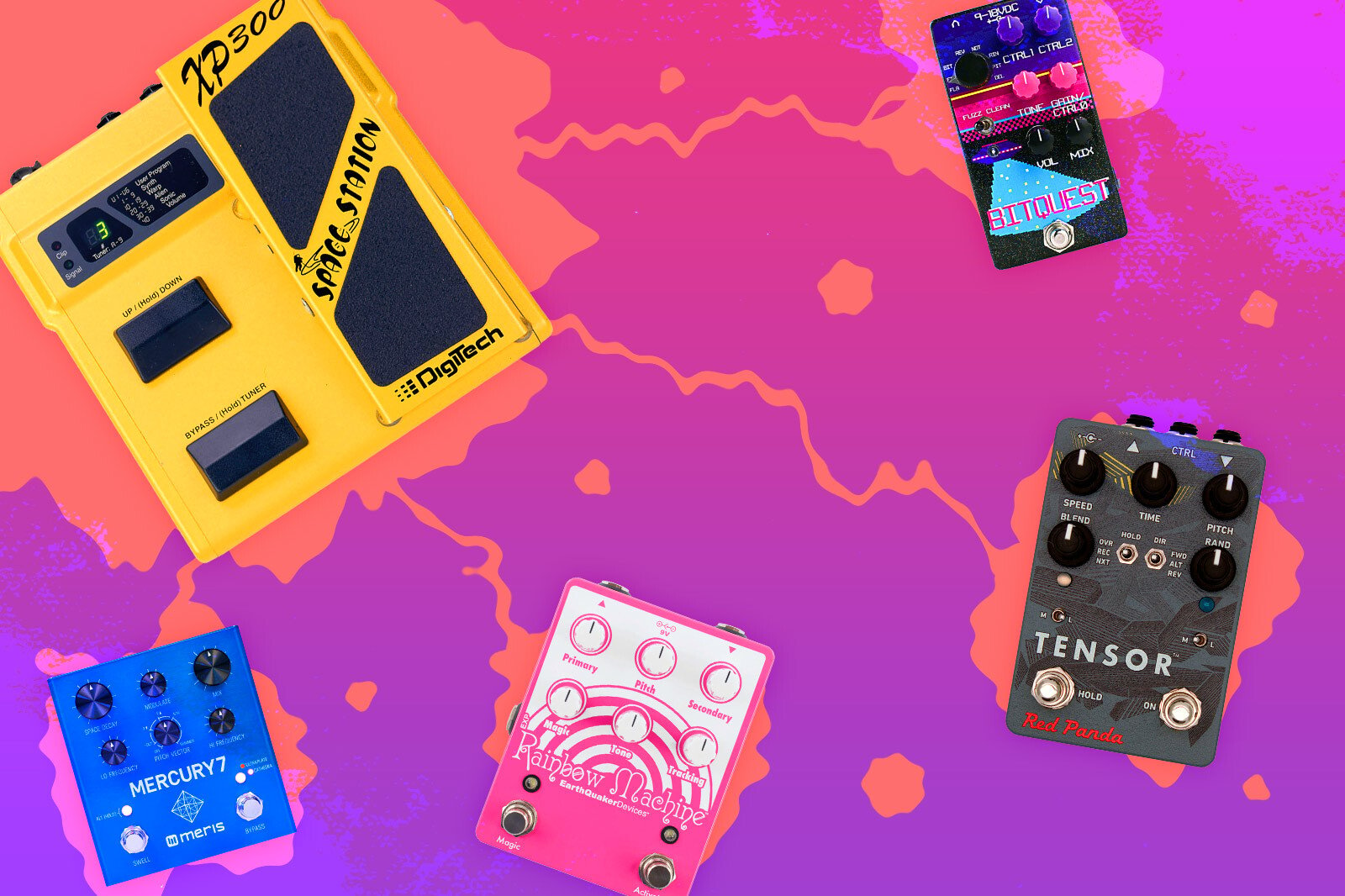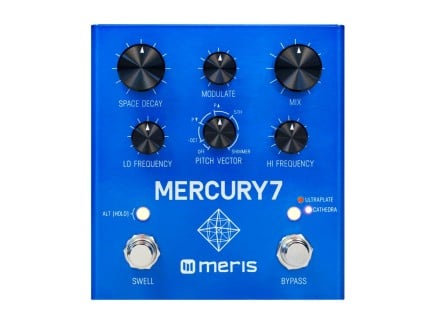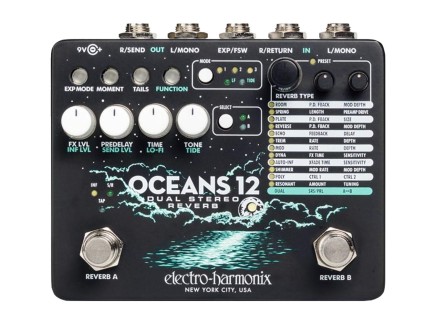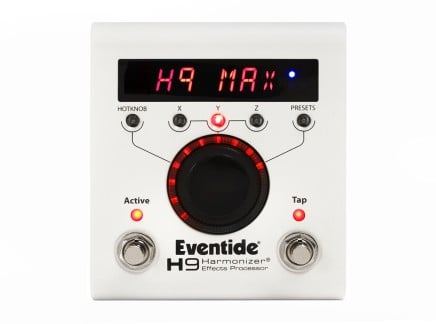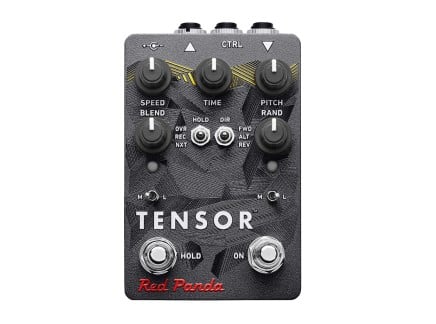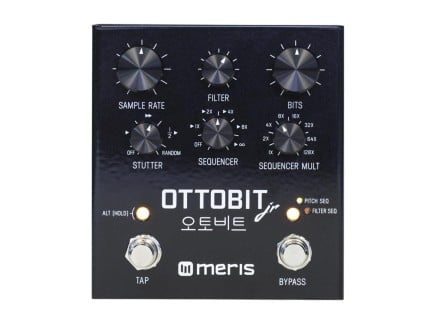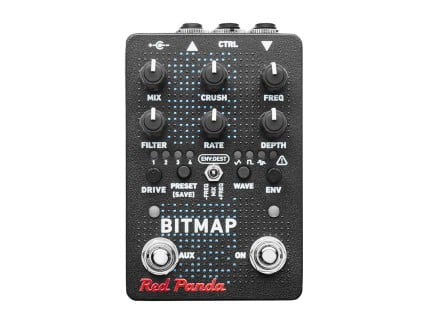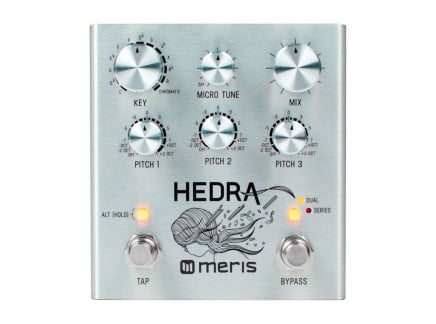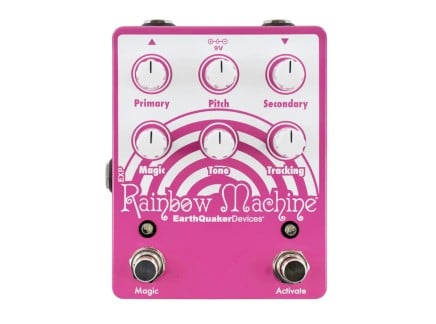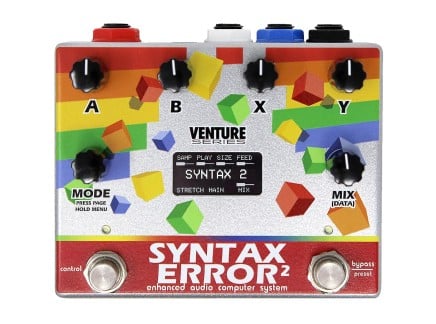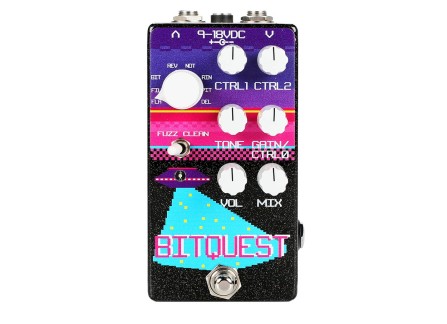Today, the world of guitar pedals is overflowing with all sorts of creative and downright bizarre effects—many capable of transforming the familiar sound of the instrument so drastically that it may not be possible for the listener to tell whether they are hearing a guitar, a synth, a flute, or a swarm of alien bees. However, the world of guitar effect pedals wasn't always like this, and in examining their history, we can look to a few groundbreaking stompboxes whose bold, strange designs spiced up some of our favorite music and influenced the future of effect design. Some of these early pedals wind up forgotten—and yet others have become highly valued, "holy grail" pieces for players and collectors.
One such pedal is the DigiTech XP-300 Space Station, a whimsical multi-effects stompbox with a wide selection of bizarre sound processing options. Quite ahead of the trends of its time, and perhaps a little bit too early for the world to be ready, the Digitech Space Station only truly gained popularity after it had already been discontinued, and thus its demand quickly outgrew its supply, skyrocketing the market value of the pedal.
So in this article, we are going to take a closer look at this pedal, its place in the history of music technology, and how to decipher what it actually does. Once it has been decoded, it becomes possible to offer a few modern effects that are capable of aiding your rig with sounds similar to the ones you could get from Space Station...with an even higher degree of customizability, capable of going well beyond the Space Station's own furthest reaches. Take your protein pills and put your helmet on—we're stepping through the door.
A Brief History of the Space Station
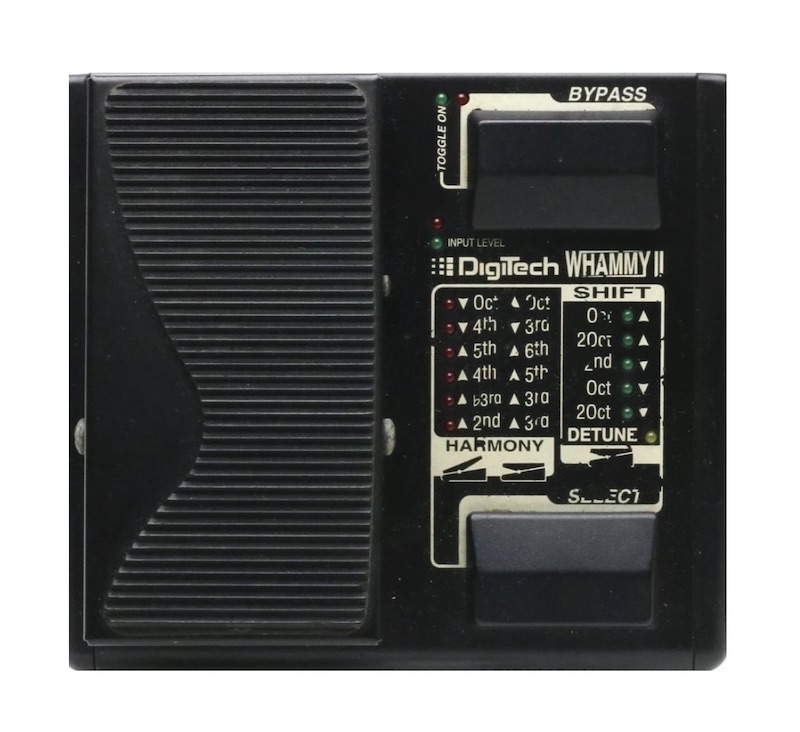 Digitech's Whammy II pitch shifter (image via modulargrid.net)
Digitech's Whammy II pitch shifter (image via modulargrid.net)
It's important to note that, during the 1990s, the realm of effects pedals was quite different from today: most pedal builders were fairly conservative, borrowing sounds and techniques from the previous couple decades and repackaging them for a new audience. The young company DigiTech, though, was looking for ways to embrace digital signal processing to bring new sounds to guitarists. Their first major success was the Whammy II, was a digital pitch shifter with foot-operated treadle control...allowing users to achieve dramatic pitch shift/dive bomb effects a la Floyd Rose tremolo system. Like its predecessor from IVL Technologies, the Whammy II was a hit—and with this success under their belts, Digitech continued to innovate. They embarked on a journey to develop a unique and experimental line of multi-effects pedals known as the XP (for Xpression) series—which, with their integrated treadle/expression pedal control, seem like a natural outgrowth of the Whammy series.
The XP series pedals include the XP-100 Whammy/Wah, the XP-200 Modulator, the XP-300 Space Station, and the XP-400 Reverberator. Each of these features a Whammy-style design centered around an expression controller/treadle which is assigned to a specific manufacturer-selected parameter in each preset. Additionally, the pedals were equipped with two switches—one for preset selection, and another one for bypassing and/or engaging a built-in tuner. Depending on the model, these pedals host between 30 to 60 presets. While the sounds themselves can't be modified by the user aside from whatever is pre-assigned to the treadle, it is possible to save up to six favorite programs as user presets for quick access during performance.

While all of the four pedals in the series offered a unique collection of effects in their distinct categories, the XP-300 has certainly become the most cherished by the current generation of adventurous guitarists, eventually developing a cult-like following. Because of this, Space Station prices on the second-hand market are typically quite high, often surpassing the $500 mark.
Interestingly, though, the design of all four pedals in the XP series features essentially the same hardware, with the exception of the EEPROM chip. As such, in recent years ambitious musicians have begun modding the pedals by replacing the chips, so it is quite common that people buy another less-coveted pedal in the series (like XP-200 or XP-400) and replace the built-in EEPROM with a chip containing the desired Space Station presets (note: the XP-100 requires more extensive hardware modifications for this than do the 200 or 400). Moreover, there also exists an ultimate modification variant to this pedal known as the "jetpack mod" or the "XP-All" which hosts all the presets from all four pedals in a single Xpression series pedal. However, given the popularity of these modifications, even the prices of the other XP pedals have been steadily rising over the years.
Because of this, we've recently found ourselves wondering...if we were to mimic the sounds of the Space Station with modern effects, how might we do it? Is it possible to recreate some of the original weirdo magic of that ugly-as-sin yellow preset box?
So...What Does the Space Station Actually Do?
The Space Station itself contains 39 presets broken into four sonically distinct categories: Synth, Warp, Alien, and Sonic...plus a dedicated preset for volume control. Obviously, the preset banks are named rather poetically or abstractly, which doesn't necessarily tell us what the effects actually do. This is part of its allure—it's actually difficult in many situations to pinpoint exactly what the individual presets are doing.
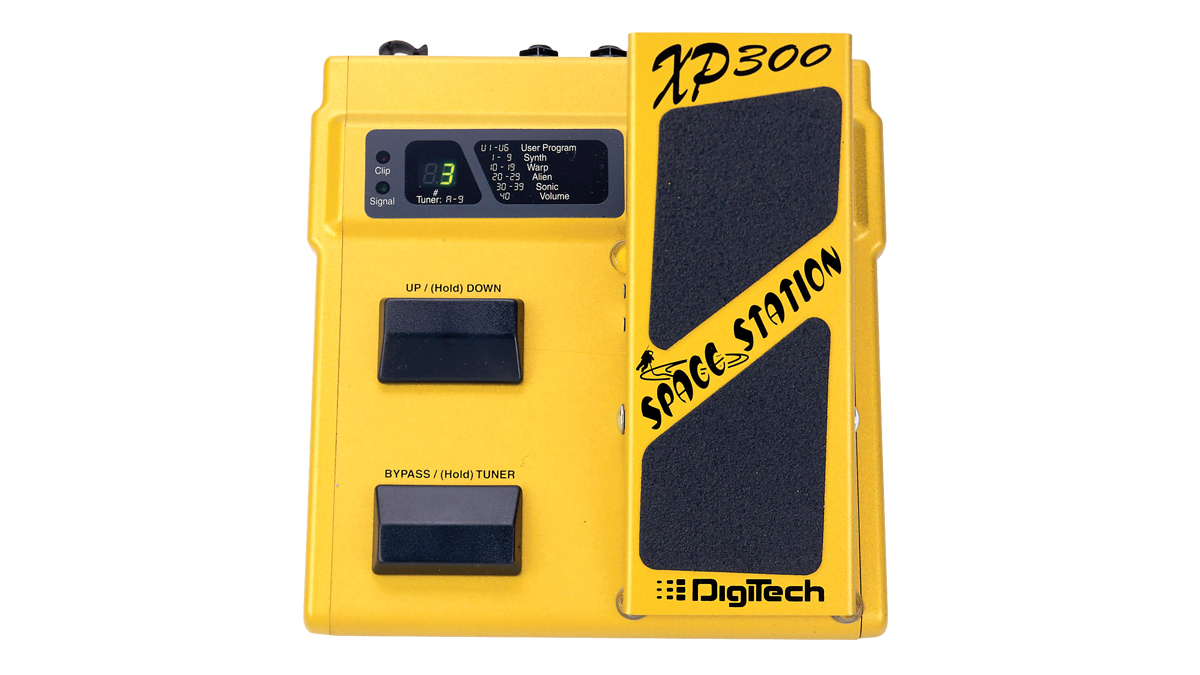
While the other XP series pedals had a fairly obvious sonic focus (whammy/wah effects, modulation effects, and reverb effects, respectively), the Space Station is more of a catch-all "weird sound" box, designed to package all sorts of peculiar processing possibilities into a single device. These range from spacious reverb-like shimmers to odd buffer manipulation techniques, pitch shifted delays, and even stranger sounds that are captivating, but difficult to understand.
So let's go bank by bank, mapping the presets out to their actual processing functions as best we can, in order to get a clearer idea of what types of sounds one could get from this pedal...and consequently, to clarify what modern alternatives could be employed to achieve similar sounds. (Note: please check out this video on Juan Alderete/Nick Reinhart's YouTube channel Pedals + Effects or this video from Ryan Burke/60 Cycle Hum for a sense of how these effects can sound! We'll offer timestamped links to these videos for reference throughout this article.)
The Space Station's Synth Presets [1–9]
While the name of this category might suggest to you that its contents are a variety of processing algorithms based on the common guitar-to-synth paradigms of pitch-trackers, comparators, envelope followers, waveforms, and filters, it really is not the case here at all. In actuality, the Synth section comprises nine presets, eight of which are variations on now hugely popular shimmer-style swelling effects—combinations of delays and/or reverbs and pitch-shifters tuned to different (often consonant) intervals such as octaves, fifths, and fourths. Thus, what you actually get from the Synth category of the Space Station isn't the same thing you'd get from a typical "guitar synth" pedal...instead, it's a compilation of synth-like lush pads and ambient soundscapes that evoke dream pop, shoegaze, post-rock, and other similar genres. (Note: check out this timestamp from the 60 Cycle Hum video to hear these sounds in action!)
 Eventide's DSP4000—released in 1994—featured several "Crystal" presets in the "Curiosities" bank similar to the XP-300's Synth presets
Eventide's DSP4000—released in 1994—featured several "Crystal" presets in the "Curiosities" bank similar to the XP-300's Synth presets
Although reverbs, delays, and pitch-shifters define the overall quality of these sounds, a big part of their character is also established by their use of volume auto-swells. The expression pedal in also plays an important role in managing the dynamics of the effect, and its assignment differs slightly from preset to preset. In some, it is used as a dry signal volume control, yet in others it is seemingly used as an effect send amount for one of multiple parallel shimmer-like effects: for instance, setting the amount of the reverberated signal sent to a higher-octave shimmer.
It seems safe to state that around the time when Space Station was released there were hardly any other pedals that could produce these sorts of sounds—these types of pitch shifted spatial effects were emerging in other (fairly expensive) studio equipment from Eventide and others (see the H3000, DSP4000, and others), but in the world of standalone pedal processing, it was quite unique. For this reason, XP-300 can rightfully be considered as one of the forerunners that brought such radically new sounds to the arsenals of creative musicians outside the context of the recording studio. And now, almost thirty years later, the pedal market is flourishing with stompboxes that produce similar shimmer effects...some of which can transcend many of the Space Station's own limitations.
One of our favorite pedals in that domain is the Mercury7 from Meris. The pedal sports two distinctly different reverb algorithms—Ultraplate and Cathedra—supported by a pair of filters for shaping the color of the effect. Moreover, reverb tails can utilize an integrated pitch-shifter, and the Pitch Vector parameter is used to shift the processed sound a 5th up, an octave below or above, or to just apply a slight detuning to it, creating reverb tails that gradually shift upward/downward over time—evoking the Space Station's peculiar evolving ambiences. There is also a dedicated Swell switch on Mercury7 to add that smooth auto-swelling effect with the attack time configurable by the user. Furthermore, an external expression pedal can also be used with Mercury7, but unlike using it solely for simple volume/effect send control like in the Space Station, the pedal can be creatively mapped to morph between two completely distinct global states. A built-in vintage-style vibrato on the input can add further undulation and motion to your sound, getting us even closer to that XP-300 sound.
It's worth noting here that many of the Synth presets in the Space Station sound quite complex...somewhere between a smeary, scattered series of short delays, chorus, and the pitch-shifted, shimmery reverb effects we're describing. Creatively combining these types of effects and exploring the space between them will prove to be rewarding—and we'll no doubt continue to try emulating these effects using different pedal combos for years to come. To get somewhat closer to the XP-300 sound, in the video above, we ran guitar into an Electro-Harmonix Pitch Fork+ for an initial mix of dry signal and pitch shift, then through an Attack Decay to create an artificial envelope swell, and then into the Mercury7, allowing us to get closer to the auto-swell, multi-pitch-shift complexity of the XP-300's synth tones.
Although Mercury7 is one of the most advanced and feature-rich shimmer-style reverb pedals currently available, it certainly is not the only one. The Electro-Harmonix Oceans 12, Eventide's H90, Strymon's Timeline, and many others are capable of that classic Eventide-esque Crystal/Shimmer effect. Oh, and before we move on—we need to mention that the last preset of the Synths category in XP-300 has nothing to do with reverbs and delays. Instead, it is a simple yet effective octave-down effect, which could be easily derived from any of the wide selection of currently available octave/pitch-shifter stompboxes.
The Space Station's Warp Presets [10–19]
The Warp section of the Space Station is one of its most peculiar and unique banks, offering ten quirky effects that in one way or another simulate the manipulation of magnetic tape, for everything from tape stop and reverse effects all the way to animated, cartoonish pitch shifting. The expression controller in these presets has a more radical mapping strategy than in the Synth tones, performing functions like slowing down, speeding up, and reversing tape (sometimes within the same preset), as well as adjusting the glide time of automated pitch shifts, like an auto-Whammy type effect. With this clever implementation of the expression pedal, XP-300 made it possible to achieve as-of-yet unheard sounds, and creative guitarists like Tom Morello (whose creative use of the Whammy pedal perhaps even inspired some of those presets), and later Nick Reinhart (whose XP-300 work can be heard across the adventurous music of his band, Tera Melos).
The Warp bank's "time warp delays" are some of its most distinct effects—again, check out the Pedals + Effects channel's Space Station video, in which Nick Reinhart and Juan Alderete demonstrate how these effects work. In these presets, the treadle allows you to simulate the sounds of continuously slowing down, speeding up, and reversing a virtual tape—allowing for tape stop bends, weird pitch shifting, and a startlingly effective through-zero tape speed shift/reverse effect. These presets were a direct inspiration for one of today's most interesting and peculiar effect pedals: Red Panda's Tensor. However, Tensor takes these effects much further.
With all other controls in their neutral position, the Tensor's Time control works identically to the Space Station's "thru-zero" tape stop/reverse effect, allowing you continuous speed shifting from normal response (forward at original pitch) when fully clockwise and original pitch/reversed sounds at fully counterclockwise. From there, the independently configurable Time and Pitch controls allow decoupled control of timestretching and pitch shifting (whereas the speed control necessarily couples these)—and as such, the user is able to create an immense variety of tones, glitchy, and stuttery effects, as well as sustained ambient textures.
Add to this three different looping and playback modes and switches that can be set to perform in either momentary or latching modes, and you've got yourself a highly interactive sound mangler that can be very rewarding in the context of performance. While in the Space Station the functions of the rocker pedal were fixed to the design of the specific preset, Tensor is much more flexible: similarly to the behavior of the Mercury7, an expression pedal can be used to morph between two radically different global states. Tensor is quite deep overall—also emulating the workflow of the much-loved Line 6 DL4 and plenty of other odd tricks of its own.
One of the breakthroughs of the XP-300 (and Tensor) is that it is possible to create the effect of sound playing in reverse nearly simultaneously with the input signal. For an alternative (but quite different) approach to such an effect, the aforementioned Attack/Decay from EHX is also a great option—rather than dealing with audio buffers, it simply applies an envelope shape with a user-definable attack directly to the sound...a sure trick to making sounds with hard transients sound as if they are reversed.
The other Warp presets employ a peculiar auto-Whammy-style pitch shift effect, where new articulations trigger a pitch glide that goes up or down an octave depending on the specific preset. In these presets, the treadle controls the glide time...for everything from slow sweeps to absolutely cartoon-like glissandi. This is a patently Nick Reinhart-style effect, turning the guitar into an absurd source of animated gestures.
You could achieve this on a modular synthesizer using a combination of an envelope follower, comparator, envelope generator, and pitch shifter—but admittedly, we've had difficulty coming up with something exactly like this in the realm of effects pedals alone! One cheat is to use EHX's Pitch Fork+, which contains a function in which you can use the built-in footswitch to trigger an internal envelope which modulates the pitch shift amount with controllable rise/fall times, allowing you to use your feet to do similar dynamic pitch sweeps. One of our favorite (somewhat convoluted) tricks involved using the Meris Hedra's pitch shift and glide functions with an expression pedal mapped to glide time. By successively playing two notes an octave apart from one another, you can create these types of cartoonish shifts...and of course, you can stretch them into more peculiar territory where notes slide between one another at variable rates. It's actually a super cool effect.
This isn't quite the same as the audio-triggered reactivity of the Space Station, and short of building such a preset on the Empress ZOIA or Poly Beebo, we're sort of stumped as to how you might achieve it...but happily our workarounds proved to be quite fun. (Editor's note: if you're reading this and have any clever ideas about how to accomplish this effect with other pedals, let us know! We'd love to hear about your tricks.)
The Space Station's Alien Presets [20–29]
We now approach a group of ten presets abstractly dubbed "Alien." These are somewhat easier to classify: this bank includes an assortment of bit crushing, sample rate reduction, ring modulation, and sample & hold filtering effects. The role of the expression controller here changes more drastically from preset to preset, allowing the users to manipulate anything from wet/dry balance to the depth of the effect to ring mod frequency or sample & hold rate. By their very nature, these presets can seem quite jarring, but if used creatively they could easily become a secret sauce in your special sonic recipe.
Sorting out these kinds of effects from the boundless landscape of modern stompboxes shouldn't be an issue. Syntax Error 2 from Alexander Pedals and Randy's Revenge from Fairfield Circuitry are great examples of modern ring modulators that are more than capable of alien-izing any sound source (note: for more thoughts on ring modulators, check out this recent article!). The realm of bit crushers and sample rate reduction pedals is also vast (in fact, Dr. Scientist's Bitquest can do this and ring modulation as well), however, because of their unapologetically harsh and digital nature, bitcrushers belong to a small group of effects that a good number of guitarists struggle to incorporate into their setups (there seems to be no such problem for users of drum machines). This is, of course, a particular challenge for effect designers...but there are a couple such pedals that are quite special, well-worth exploring in greater depth here.
Without a doubt, Red Panda's Bitmap 2 and Meris's Ottobit Jr. represent two of the most creative and innovative approaches to this effect in a stompbox format. While they are quite different from one another, there are a couple of things that set each apart from the rest of the crowd. First of all, in both pedals, the harshness induced by the aliasing in bitcrusher effects is gracefully toned down with characterful lowpass filters, which additionally opens up the possibility to create very synth-like tones. Secondly, the pedals are endowed with internal modulation, allowing the user to animate the effect in a variety of ways. In the case of Bitmap 2, modulation is handled by a multi-waveform LFO. In Ottobit Jr, movement is facilitated by an audio-triggerable six-step sequencer for modulating sample rate, bit depth, filter frequency, or pitch shift amount.
Of course, each of these pedals have their own strong suits beyond their distinct modulation types: Bitmap 2 contains a stellar wavefolder/waveshaper for adding a ton of synth-like tonal options, while Ottobit Jr. offers pitch shifting and a dynamic stuttering playback option for all manner of audio glitches. Both pedals feature the flexible expression pedal mapping system that both brands are known for, which makes them even more configurable and adaptive to a musician's performance needs. Because it is fully up to the user which parameters are controlled by the expression controller, the range of applications is immense—for example, given the on-board filters, it is easy to fashion unique sounding filter sequence or wah-like effects.
Speaking of filters, it is well worth addressing the "Sample & Hold" Alien presets on the Space Station, which are essentially constructed by the signal passing through a resonant filter, with a random stepped sample & hold modulating the filter's cutoff frequency—a classic sound effect from the realm of early sci-fi. There are a number of modern pedals that can achieve exactly this effect...including Earthquaker's appropriately-named Spatial Delivery (demonstrated above) and Dr. Scientist's Dusk.
Similarly to an exercise we did earlier, the modulated bitcrusher and filter effects can of course created using several simpler pedals. For example, EHX's 8-Step Program sequencer can be a good candidate for modulating a filter's frequency or bitcrusher amount in pedals that have expression pedal input.
The Space Station's Sonic Presets [30–39]
The last bank of presets bears the mysterious label "Sonic." Collectively, they are a collection of resonators and gnarly arpeggiator-like pitch-shifted delays: sounds perfectly fitting for scoring psychedelic cartoons with a twist of horror. The use of the expression pedal here is largely assigned to simple functions like input volume or a dry/wet blend...which proves to be quite useful, given the complexity of the processed output. Again, check out the 60 Cycle Hum video for a sense of how these sound...and then, let's dissect the resonator-like presets.
The resonator presets are similar to very short delays with high feedback amounts, creating the sense of a sound passing through vibrating sympathetic strings or other metallic objects. This imbues your sound with peculiar resonances and reinforces different overtones in unpredictable ways. We found that these types of sounds can be reproduced very accurately with flanger pedals—after all, a flanger is just a very short delay line. Using the Earthquaker Pyramids with the modulation "width" set fully counterclockwise and feedback relatively high, you can achieve a wide variety of ringing, static flanging effects quite similar to the XP-300's resonators. Of course, any digital delay set to similar short times will behave similarly—but Pyramids sounds just great with these types of settings, and really comes to life using the Trigger modes to dynamically modulate the delay time / flange amount / resonator pitch. Not dissimilar effects can also be achieved with the EHX Oceans 12, also featured in the second part of our video above—using its resonator programs offers a somewhat more tame, soft, spacious, and customizable version of these jarring, peculiar sounds.
The remainder of the Sonic presets are pitch shifted delay sounds—a long-standing studio trick found in various Eventide processors and the like. The XP-300 was one of the first devices to introduce this into the realm of effect pedals, turning individual articulated sounds into cascading echoes that continually trail upward in downward in pitch (check out the intro of the Tera Melos track "System Preferences" from 2017's Trash Generator to hear this XP-300 effect in action).
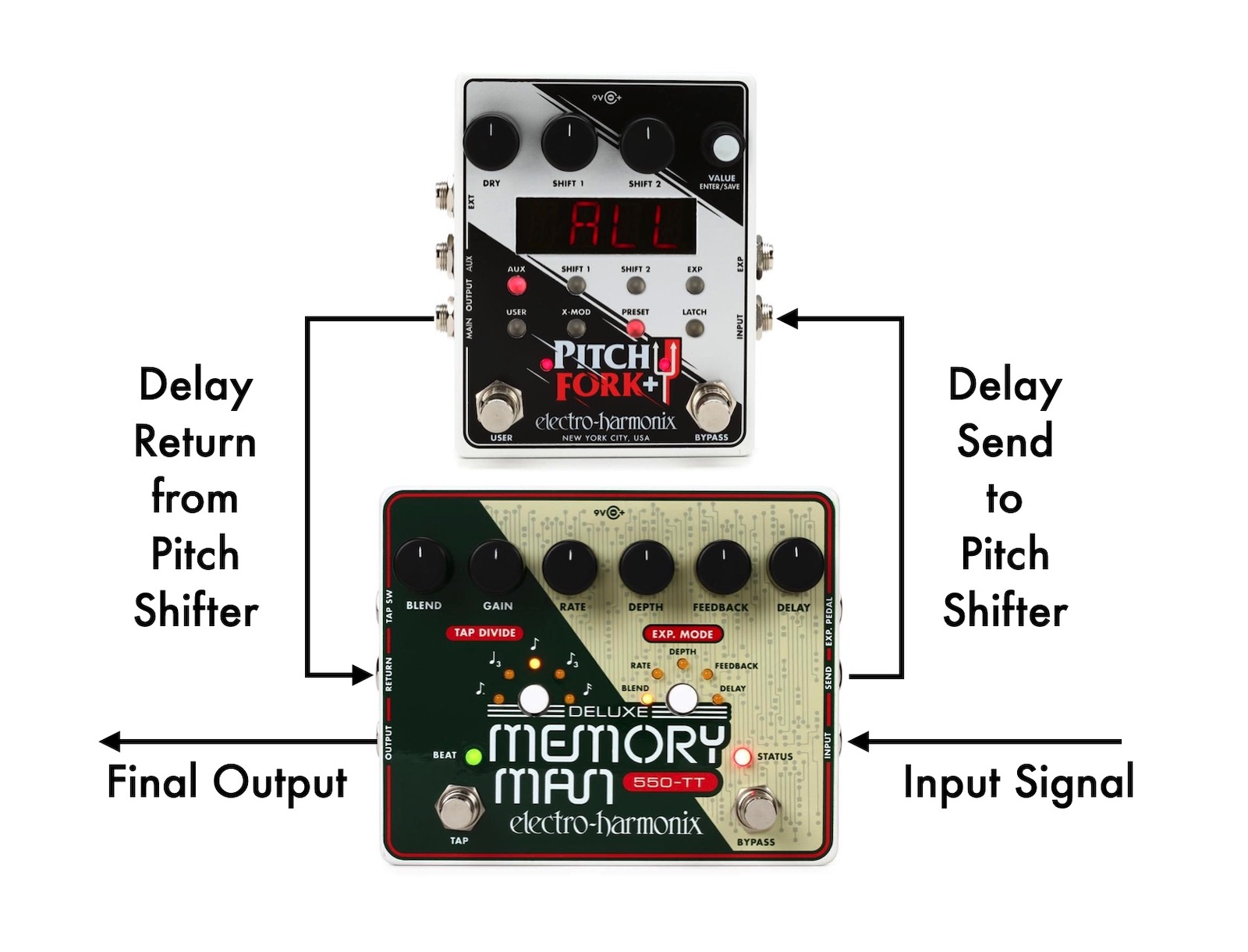 Setup for inserting a pitch shifter into a delay's feedback loop
Setup for inserting a pitch shifter into a delay's feedback loop
This effect can be achieved by inserting a pitch shifter not before or after a delay, but into the delay's feedback loop itself. The resulting otherworldly arpeggios have an inherent tendency toward symmetrical chords and other harmonically ambiguous sonorities: tritones, diminished seventh chords, augmented triads, quartal and quintal harmonies, whole-tone scales, and chromatic clusters. This can be achieved with any delay with a built-in FX loop (EHX Deluxe Memory Man 550-TT or 1100-TT, for instance) and an external pitch shifter...but this technique has actually become quite standard—and in fact, one of the most popular pedals capable of this effect is another from the mind of Earthquaker's Jamie Stillman.
Described plainly by EQD as a polyphonic pitch-shifter, it is somewhat difficult to explain what Rainbow Machine does, especially with parameter names like Primary, Secondary, and Magic. In practice, the pedal encapsulates a wide range sonic potential in the realm of modulation effects with a noticeably distinct accent on weird, wild, and bizarre, largely based on the types of pitch-shifted delays described above. Particularly interesting here is the range of the pitch control, which goes from the 4th down to a 3rd up, unlike the typical maximum shift of at least one octave as in most pitch-shifters. However, the Secondary parameter then adds another layer of the sound shifted either an octave up or down from the interval set by the Pitch control. Then there is the Tracking parameter that sets the lag time between the dry and wet signals, and finally there is Magic—a control over feedback amount that is only active once the corresponding same-named switch is pressed. Sonically, Rainbow Machine is easily capable of sounds similar to the arpeggiator effects found on the Space Station, and much-much more—anything from subtle chorusing, to trippy flanging to savory drones, and cascading pitch-shifted delay madness.
We must mention here as well that Meris's Hedra offers a distinct and highly-refined take on the same concepts. With three individual pitch shifters each with their own delay lines and a variety of internal feedback routing options, it becomes possible to create rich tapestries of cascading harmony—almost like three XP-300 arpeggiator presets in a single pedal. What's more, Hedra can lock the produced pitches to specific user-selectable scales, turning the harmonic ambiguity of typical pitch-shifted delays into something that shimmers and shines beautifully (or terrifyingly) no matter what sound is sent into it. Hedra is, of course, capable of much more as well, from the peculiar pitch shifted glides described to Eventide-style chorusing, hard-tuning a la Auto-Tune, and abrasive washes of all-out noise. To call it a rhythmic pitch shifter is an understatement.
Disembarking from the Space Station
So we've come to the end of our tour of the XP-300, a modern-day oddity in the world of audio technology. In this day and age, most of its effects can be emulated (and in fact, surpassed) by other processors—and its starkly minimal user interface means that it isn't nearly as open-ended as most modern guitar effect pedals. That being the case...why has it become so sought-after?
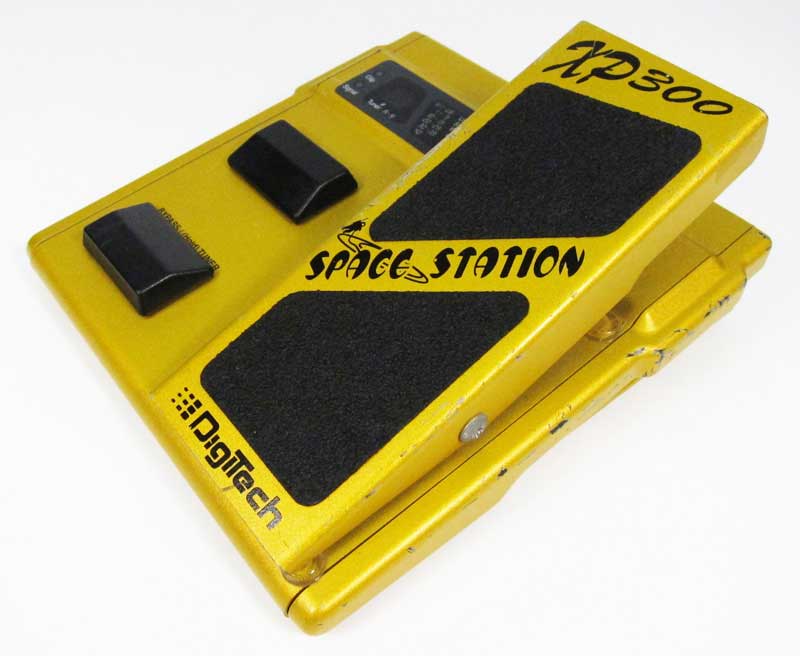
What is perhaps most interesting about the Space Station is that it wasn't perfect, and it wasn't particularly universal. Instead, it is its quirkiness, limitations, and a very strange combination of effects that made it stand out among hundreds of other pedals and earn a dedicated group of followers. It seems that by taking so much liberty in deciding what sounds would be included, and which parameters were controllable for each, DigiTech essentially left musicians with only one potential objective: to creatively explore the presets and make music with them. While this strategy certainly doesn't work for everyone and everything, it did appear to be exactly the right mix of things for the XP-300, providing it a unique place in the history of effects pedals...and unwittingly to set the trajectory for the future of wacky, weird, and experimental effects.
In this article, we've listed a decent number of alternative modern pedals that not only are capable of replicating the particular effects found on Space Station, and in most cases, they do go way deeper and offer more options for customization. While XP-300's limitations and its history certainly add to its charm and performability, it is still a rare piece to find these days—especially at a reasonable price. And for this reason, we hope that our recommendations will serve as a mini-guide for finding a particular Space Station-inspired effect, or simply as a spur to design your very own custom weird effects rig.

